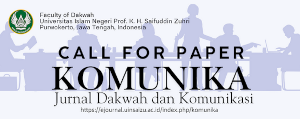Improving Communication and Collaboration Skills via e-Learning Contents
DOI:
https://doi.org/10.24090/komunika.v14i2.3570Keywords:
communication, collaboration skill, e-learningAbstract
Developing e-learning content at a boarding university needs communication and collaboration skills. This study aims to discuss the strategy of improving communication and collaboration skills via e-learning content. This study uses a descriptive qualitative method. Data were collected through observation and interviews with stakeholders and lecturers. This study found that the strategy of improving the communication and collaboration skills via e-learning contents at the boarding university is conducted through four stages. The four stages are access, analysis, evaluation, and content creation: (1) The access is made by lecturers and students at the University of Darussalam Gontor in the form of the ability to use and utilize e-learning models. (2) The analysis phase is in the form of the ability of lecturers to find, change, and select information relevant to the learning process. The analysis phase also deals with the verification step (tabayyun) of the accuracy of the information. (3) Evaluation is in the form of preparation of learning contents adjusted to the real conditions occurring in the community or referred to as contextual learning. (4) Development of learning content is applied to five basic courses in the Communication Studies Program.Downloads
Download data is not yet available.
References
Atiah, N. (2020). Pembelajaran Era Disruptif Menuju Masyarakat 5.0. Prosiding Seminar Nasional Pendidikan Program Pascasarjana Universitas Pgri Palembang 10 Januari 2020, 605–617.
Bachri, B. S. (2010). Meyakinkan Validitas Data melalui Triangulasi pada Penelitian Kualitatif. Jurnal Teknologi Pendidikan, 10(1), 46–62.
Bashori, A. H. (2016). Studi Kritis Konsep Sanad Kitab Nahj al-Balaghah sebagai Upaya Membangun Budaya Tabayyun dalam Keilmuan Islam. El-Harakah (terakreditasi), 18(2), 163–183. https://doi.org/10.18860/el.v18i2.36 58
Fukuyama, M. (2018). Society 5.0: Aiming for a New Human-centered Society. Japan Spotlight, 47–50.
JISC. (2017). Developing digital literacies | Jisc. Jisc.
Khamidah, K., & Triyono, R. A. (2013). Pengembangan Aplikasi E-Learning Berbasis Web dengan PHP dan MYSQL Studi Kasus SMPN 1 Arjosari. IJNS- Indonesian Jurnal on Networking and Security, 2(2), 1–7.
Mar’ati, R. (2014). Pesantren sebagai Basis Pendidikan Karakter; Tinjauan Psikologis. Al-Murabbi: Jurnal Studi Kependidikan dan Keislaman, 1(1), 1– 15.
Nurhakim, M. (2011). Imam Zarkasyi dan Pembaharuan Pesantren : Rekonstruksi Aspek Kurikulum, Menejemen dan Etika Pendidikan. Progresiva, 5(1), 83–96.
Priatmoko, S. (2018). Memperkuat Eksistensi Pendidikan Islam di Era 4.0. TA’LIM: Jurnal Studi Pendidikan Islam, 1(2), 1–19.
Rizal, A. S. (2011). Transformasi Corak Edukasi dalam Sistem Pendidikan Pesantren dari Pola Tradisi ke Pola Modern. Pendidikan Agama Islam, 9(2), 95–112.
Rohman, N. (2019). Penguatan Karakter dan Literasi Baru pada Sekolah Berbasis Boarding Menjawab Tantangan Era Society 5.0. Seminar Nasional Pascasarjana 2019, 247–250.
Sulianto, J. (2011). Keefektifan Model Pembelajaran Kontekstual dengan Pendekatan Open Ended dalam Aspek Penalaran dan Pemecahan Pada Materi Segitiga di Kelas VII. Ilmu Pendidikan, 17(6), 454–458.
Tamin, I. H. (2011). Peran Filantropi dalam pengentasan Kemiskinan di dalam Komunitas Lokal. Jurnal Sosiologi Islam, 1(1), 35–58.
Umam, Kaiful; Zaini, I. (2013). Penerapan Media Digital dalam Pembelajaran Apresiasi Batik Kelas X SMA Negeri 1 Blega. Jurnal Pendidikan Seni Rupa, 1(1), 100–105.
Bachri, B. S. (2010). Meyakinkan Validitas Data melalui Triangulasi pada Penelitian Kualitatif. Jurnal Teknologi Pendidikan, 10(1), 46–62.
Bashori, A. H. (2016). Studi Kritis Konsep Sanad Kitab Nahj al-Balaghah sebagai Upaya Membangun Budaya Tabayyun dalam Keilmuan Islam. El-Harakah (terakreditasi), 18(2), 163–183. https://doi.org/10.18860/el.v18i2.36 58
Fukuyama, M. (2018). Society 5.0: Aiming for a New Human-centered Society. Japan Spotlight, 47–50.
JISC. (2017). Developing digital literacies | Jisc. Jisc.
Khamidah, K., & Triyono, R. A. (2013). Pengembangan Aplikasi E-Learning Berbasis Web dengan PHP dan MYSQL Studi Kasus SMPN 1 Arjosari. IJNS- Indonesian Jurnal on Networking and Security, 2(2), 1–7.
Mar’ati, R. (2014). Pesantren sebagai Basis Pendidikan Karakter; Tinjauan Psikologis. Al-Murabbi: Jurnal Studi Kependidikan dan Keislaman, 1(1), 1– 15.
Nurhakim, M. (2011). Imam Zarkasyi dan Pembaharuan Pesantren : Rekonstruksi Aspek Kurikulum, Menejemen dan Etika Pendidikan. Progresiva, 5(1), 83–96.
Priatmoko, S. (2018). Memperkuat Eksistensi Pendidikan Islam di Era 4.0. TA’LIM: Jurnal Studi Pendidikan Islam, 1(2), 1–19.
Rizal, A. S. (2011). Transformasi Corak Edukasi dalam Sistem Pendidikan Pesantren dari Pola Tradisi ke Pola Modern. Pendidikan Agama Islam, 9(2), 95–112.
Rohman, N. (2019). Penguatan Karakter dan Literasi Baru pada Sekolah Berbasis Boarding Menjawab Tantangan Era Society 5.0. Seminar Nasional Pascasarjana 2019, 247–250.
Sulianto, J. (2011). Keefektifan Model Pembelajaran Kontekstual dengan Pendekatan Open Ended dalam Aspek Penalaran dan Pemecahan Pada Materi Segitiga di Kelas VII. Ilmu Pendidikan, 17(6), 454–458.
Tamin, I. H. (2011). Peran Filantropi dalam pengentasan Kemiskinan di dalam Komunitas Lokal. Jurnal Sosiologi Islam, 1(1), 35–58.
Umam, Kaiful; Zaini, I. (2013). Penerapan Media Digital dalam Pembelajaran Apresiasi Batik Kelas X SMA Negeri 1 Blega. Jurnal Pendidikan Seni Rupa, 1(1), 100–105.
Downloads
Published
2020-10-01
Issue
Section
Articles
License
Authors who publish with this journal agree to the following terms:
- Authors retain copyright and grant the journal right of first publication with the work simultaneously licensed under a Creative Commons Attribution-ShareAlike 4.0 International License that allows others to share the work with an acknowledgement of the work's authorship and initial publication in this journal.
- Authors are able to enter into separate, additional contractual arrangements for the non-exclusive distribution of the journal's published version of the work (e.g., post it to an institutional repository or publish it in a book), with an acknowledgement of its initial publication in this journal.
- Authors are permitted and encouraged to post their work online (e.g., in institutional repositories or on their website) prior to and during the submission process, as it can lead to productive exchanges, as well as earlier and greater citation of published work (See The Effect of Open Access).

























